An Eye Tracking Study of Attention to Print Advertisements: Effects of Typeface Figuration
Abstract
:Introduction
Theoretical background
- H1: Typeface figuration will have a positive influence on viewers’ response. Particularly, the figuration that generates a more irregular form of the typeface (trope) will positively influence attitude toward an ad and a brand, as well as have the positive influence on purchase intention in low involvement conditions of viewing advertisements.
Attention and information processing
- H2a: Typeface figuration compared to no figuration of a typeface will have no significant impact on fixation frequency for typefaces that are approximately the same in size.
- H2b: Typeface figuration will have an impact on total fixation duration. Particularly, total fixation duration is expected to be greater for the figuration that generates a more irregular form of the typeface (trope).
Effects of the product type and spokesperson type
- H3: Typeface figuration will be more beneficial when hedonic features as compared to utilitarian features of the product are highlighted.
Method
Design and stimuli
Independent variables
Measures
Participants and procedure
Results
Effects of typeface figuration on attitude
Interaction between figuration and product type
Discussion
Implications and conclusions
Limitations and future research
Acknowledgments
References
- Anderson, R. E., and M. A. Jolson. 1980. Technical wording in advertising: Implications for market segmentation. The Journal of Marketing 44, 1: 57–66. [Google Scholar] [CrossRef]
- Berger, S., U. Wagner, and C. Schwand. 2012. Assessing Advertising Effectiveness: The Potential of GoalDirected Behavior. Psychology & Marketing 29, 6: 411–421. [Google Scholar]
- Berlyne, D. 1971. Aesthetics and psychobiology. Retrieved from http://doi.apa.org/psycinfo/1973-00821-000. [Google Scholar]
- Bonsiepe, G. 1965. Visual/verbal rhetoric. Ulm: Journal of the Ulm School of Design 14/15: 69–82. [Google Scholar]
- Brinton, J. E. 1961. The “feeling”of type faces. CA Magazine 3: 43–45. [Google Scholar]
- Brumberger, E. R. 2003. The Rhetoric of Typography: The Persona of Typeface and Text. Technical Communication 50, 2: 206–223. [Google Scholar]
- Bush, A. J., W. C. Moncrief, and V. A. Ziethaml. 1987. Source effects in professional services advertising. Current Issues and Research in Advertising 10, 1–2: 153–171. [Google Scholar]
- Childers, T. L. 1992. The Role of Expectancy and Relevancy in Memory for Verbal and Visual Information: What Is Incongruency? Journal of Consumer Research 18, 4: 475–492. [Google Scholar]
- Childers, T. L., and M. J. Houston. 1984. Conditions for a picture-superiority effect on consumer memory. Journal of Consumer Research 11, 2: 643–654. [Google Scholar] [CrossRef]
- Childers, T. L., and J. Jass. 2002. All Dressed Up With Something to Say: Effects of Typeface Semantic Associations on Brand Perceptions and Consumer Memory. Journal of Consumer Psychology 12, 2: 93–106. [Google Scholar] [CrossRef]
- Corbett, E. P. J. 1990. Classical rhetoric for the modern student. Oxford University Press. [Google Scholar]
- Couronné, T., A. Guérin-Dugué, M. Dubois, P. Faye, and C. Marendaz. 2010. A statistical mixture method to reveal bottom-up and top-down factors guiding the eye-movements. Journal of Eye Movement Research 3, 2: 1–13. [Google Scholar] [CrossRef]
- Cox, D. S., and A. D. Cox. 1988. What does familiarity breed? Complexity as a moderator of repetition effects in advertisement evaluation. Journal of Consumer Research 15, 1: 111–116. [Google Scholar]
- Davis, R. C., and H. J. Smith. 1933. Determinants of feeling tone in type faces. Journal of Applied Psychology 17, 6: 742. [Google Scholar] [CrossRef]
- De Saussure, F. 1972. Edited by C. Bailly and A. Séchehaye. Cours de linguistique générale. In Collection Payothèque. Collection Payothèque, Grande Bibliothèque Payot. [Google Scholar]
- Delbaere, M., E. F. Mcquarrie, and B. J. Phillips. 2011. Personification in Advertising Using a Visual Metaphor to Trigger Anthropomorphism. Journal of Advertising 40, 1: 121–130. [Google Scholar] [CrossRef]
- DeRosia, E. D. 2008. Edited by E. F. McQuarrie and B. J. Phillips. Rediscovering theory: Integrating ancient hypotheses and modern empirical evidence of the audience-response effects of rhetorical figures. In Go Figure! New Directions in Advertising Rhetoric. M.E. Sharpe: pp. 23–50. [Google Scholar]
- Desimone, R., and J. Duncan. 1995. Neural mechanisms of selective visual attention. Annual Review of Neuroscience 18, 1: 193–222. [Google Scholar] [CrossRef]
- Deubel, H., and W. X. Schneider. 1996. Saccade target selection and object recognition: Evidence for a common attentional mechanism. Vision Research 36, 12: 1827–1837. [Google Scholar] [CrossRef]
- Djamasbi, S., M. Siegel, and T. Tullis. 2010. Generation Y, web design, and eye tracking. International Journal of Human-Computer Studies 68, 5: 307–323. [Google Scholar]
- Doyle, J. R., and P. a. Bottomley. 2006. Dressed for the Occasion: Font-Product Congruity in the Perception of Logotype. Journal of Consumer Psychology 16, 2: 112–123. [Google Scholar] [CrossRef]
- Duchowski, A. 2007. Eye tracking methodology: Theory and practice. Eye Tracking Methodology: Theory and Practice. Springer. [Google Scholar] [CrossRef]
- Eco, U. 1973. Kultura, informacija, komunikacija (Original t). Nolit, Beograd. [Google Scholar]
- Eco, U. 1976. A Theory of Semiotics. Indiana University Press. [Google Scholar]
- Foltz, G. S., S. E. Poltrock, and G. R. Potts. 1984. Mental comparison of size and magnitude: Size congruity effects. Journal of Experimental Psychology: Learning, Memory, and Cognition 10, 3: 442. [Google Scholar] [CrossRef]
- Franken, G., A. Podlesek, and K. Možina. 2014. Eyetracking Study of Reading Speed from LCD Displays: Influence of Type Style and Type Size. Journal of Eye Movement Research 8, 1: 1–8. [Google Scholar] [CrossRef]
- Gkiouzepas, L., and M. Hogg. 2011. Articulating a new framework for visual metaphors in advertising. Journal of Advertising 40, 1: 103–120. [Google Scholar] [CrossRef]
- Hanno, E., and E. Lupton. 1988. Rhetorical handbook: An illustrated manual for graphic designers. Design Papers 5: 1–39. [Google Scholar]
- Hanssens, D. M., and B. A. Weitz. 1980. The effectiveness of industrial print advertisements across product categories. Journal of Marketing Research 17, 3: 294–306. [Google Scholar]
- Henderson, P. W., J. L. Giese, and J. A. Cote. 2004. Impression management using typeface design. Journal of Marketing 68, 4: 60–72. Available online: http://www.jstor.org/stable/10.2307/30162016. [CrossRef]
- Higgins, E., M. Leinenger, and K. Rayner. 2014. Eye movements when viewing advertisements. Frontiers in Psychology 5, MAR: 1–21. [Google Scholar] [CrossRef]
- Holbrook, M. B., and D. R. Lehmann. 1980. Form versus content in predicting Starch scores. Journal of Advertising Research 20, 4: 53–62. [Google Scholar]
- Holbrook, M. B., and J. O’Shaughnessy. 1984. The role of emotion in advertising. Psychology & Marketing 1, 2: 45–64. [Google Scholar]
- ISO 3664:2009, 2015, Conditions, Graphic Technology and Photography—Viewing.
- Johar, J. S., and M. J. Sirgy. 1991. Value-expressive versus utilitarian advertising appeals: When and why to use which appeal. Journal of Advertising 20, 3: 23–33. [Google Scholar]
- Kjeldsen, J. E. 2012. Pictorial Argumentation in Advertising: Visual Tropes and Figures as a Way of Creating Visual Argumentation. In Topical themes in argumentation theory. Springer Netherlands: pp. 239–255. [Google Scholar] [CrossRef]
- Kostić, A. 2006. Edited by S. G. Marković and M. Isić. Kognitivna psihologija. In Zavod za udžbenike i nastavna sredstva. Beograd. [Google Scholar]
- Lee, J., and J.-H. Ahn. 2012. Attention to Banner Ads and Their Effectiveness: An Eye-Tracking Approach. International Journal of Electronic Commerce 17, 1: 119–137. [Google Scholar] [CrossRef]
- Leeuwen, T. van. 2006. Towards a semiotics of typography. Information Design Journal 4, 2: 139–155. [Google Scholar]
- Lewis, C., and P. Walker. 1989. Typographic influences on reading. British Journal of Psychology 80, 2: 241–257. Available online: http://www.ncbi.nlm.nih.gov/pubmed/2736343. [CrossRef]
- Lowrey, T. M. 1998. The effects of syntactic complexity on advertising persuasiveness. Journal of Consumer Psychology 7, 2: 187–206. [Google Scholar]
- Mackenzie, S. B., R. J. Lutz, and G. E. Belch. 1986. The Role of Attitude Toward the Ad as a Mediator of Advertising Effectiveness: A Test Competing Explanations. Journal of Marketing Research 23, 2: 130–143. [Google Scholar] [CrossRef]
- Mackiewicz, J., and R. Moeller. 2004. Why people perceive typefaces to have different personalities. International Professional Communication Conference, 2004. IPCC 2004. Proceedings, 304–313. [Google Scholar] [CrossRef]
- McCarthy, M. S., and D. L. Mothersbaugh. 2002. Effects of typographic factors in advertising-based persuasion: A general model and initial empirical tests. Psychology and Marketing 19, 7–8: 663–691. [Google Scholar] [CrossRef]
- McQuarrie, E. F., and D. G. Mick. 1996. Figures of rhetoric in advertising language. Journal of Consumer Research 22, 4: 424–438. Available online: http://www.jstor.org/stable/10.2307/2489791. [CrossRef]
- Mcquarrie, E. F., and D. G. Mick. 1999. Visual Rhetoric in Advertising: Text-Interpretive, Experimental, and Reader-Response Analyses. Journal of Consumer Research 26, 1: 37–54. [Google Scholar]
- McQuarrie, E. F., and D. G. Mick. 2003. Visual and verbal rhetorical figures under directed processing versus incidental exposure to advertising. Journal of Consumer Research 29, 4: 579–587. [Google Scholar] [CrossRef]
- Mehrabian, A., and J. A. Russell. 1974. An approach to environmental psychology. Massachusetts Institute of Technology Press. [Google Scholar]
- Mick, D. 1986. Consumer research and semiotics: Exploring the morphology of signs, symbols, and significance. Journal of Consumer Research 13, 2: 196–213. [Google Scholar]
- Mick, D. G., and L. G. Politi. 1989. Consumers’ interpretations of advertising imagery: A visit to the hell of connotation. Interpretive Consumer Research Special Vo: 85–96. [Google Scholar]
- Mitchell, A. A., and J. C. Olson. 1981. Are product attribute beliefs the only mediator of advertising effects on brand attitude? Journal of Marketing Research 18, 3: 318–332. [Google Scholar]
- Morris, J. D., C. Woo, J. A. Geason, and J. Kim. 2002. The power of affect: Predicting intention. Journal of Advertising Research 42, 3: 7–17. [Google Scholar]
- Morrison, B. J., and M. J. Dainoff. 1972. Advertisement Complexity and Looking Time. Journal of Marketing Research 9, 4: 396–400. [Google Scholar]
- Morrison, G. R. 1986. Communicability of the emotional connotation of type. ECTJ 34, 4: 235–244. [Google Scholar]
- Mothersbaugh, D. L., B. A. Huhmann, and G. R. Franke. 2002. Combinatory and Separative Effects of Rhetorical Figures on Consumers’ Effort and Focus in Ad Processing. Journal of Consumer Research 28, 4: 589–602. [Google Scholar] [CrossRef]
- Groupe, Mu. 1992. Traité du Signe Visuel Pour Une Rhétorique de L’Image. Seuil. [Google Scholar]
- Nedeljković, U., D. Novaković, I. Puškarević, and I. Tomić. 2014. Helvetica as a type convention for the youthful and trendy image: A consumer response to designer safe option. Marketing 45, 1: 50–62. [Google Scholar]
- Nedeljković, U., I. Puškarević, B. Banjanin, and I. Pinćjer. 2013. Legibility based on differentiation of characters: A review of empirical findings fundamental for type design practice. Journal of Graphic Engineering and Design 4, 1: 17–27. [Google Scholar]
- Nedeljković, Uroš, Dragoljub Novaković, and Ivan Pinćjer. 2015 forthcoming 2017. Detecting universal structure and effects of typefaces. Tehnički vjesnik/Technical Gazette 24, 2. [Google Scholar]
- Ohanian, R. 1990. Construction and validation of a scale to measure celebrity endorsers’ perceived expertise, trustworthiness, and attractiveness. Journal of Advertising 19, 3: 39–52. [Google Scholar]
- Osgood, C. E., G. J. Suci, and P. H. Tannenbaum. 1957. The measurement of meaning. University of Illinois Press. [Google Scholar]
- Palmer, S. E. 1999. Vision science: Photons to phenomenology. MIT press: vol. 1. [Google Scholar]
- Pelli, D. G., C. W. Burns, B. Farell, and D. C. Moore-Page. 2006. Feature detection and letter identification. Vision Research 46, 28: 4646–4674. [Google Scholar]
- Peracchio, L. A., and J. Meyers-Levy. 1994. How ambiguous cropped objects in ad photos can affect product evaluations. Journal of Consumer Research 21, 1: 190–204. [Google Scholar]
- Pieters, R., L. Warlop, and M. Wedel. 2002. Breaking Through the Clutter: Benefits of Advertisement Originality and Familiarity for Brand Attention and Memory. Management Science 48, 6: 765–781. [Google Scholar] [CrossRef]
- Pieters, R., and M. Wedel. 2004. Attention Capture and Transfer in Advertising: Brand, Pictorial, and TextSize Effects. Journal of Marketing 68, 2: 36–50. [Google Scholar] [CrossRef]
- Pieters, R., M. Wedel, and R. Batra. 2010. The stopping power of advertising: Measures and effects of visual complexity. Journal of Marketing 74, 5: 48–60. [Google Scholar]
- Pušnik, N., K. Možina, and A. Podlesek. 2016. Effect of typeface, letter case and position on recognition of short words presented on-screen. Behaviour & Information Technology 35, 6: 442–451. [Google Scholar] [CrossRef]
- Pušnik, N., A. Podlesek, and K. Možina. 2016. Typeface comparison− Does the x-height of lower-case letters increased to the size of upper-case letters speed up recognition? International Journal of Industrial Ergonomics 54: 164–169. [Google Scholar] [CrossRef]
- Rayner, K. 1998. Eye movements in reading and information processing: 20 years of research. Psychological Bulletin 124, 3: 372. [Google Scholar] [CrossRef]
- Rayner, K. 2009. Eye movements and attention in reading, scene perception, and visual search. The Quarterly Journal of Experimental Psychology 62, 8: 1457–1506. [Google Scholar]
- Rayner, K., B. Miller, and C. M. Rotello. 2008. Eye movements when looking at print advertisements: The goal of the viewer matters. Applied Cognitive Psychology 22, 5: 697–707. [Google Scholar]
- Rayner, K., C. M. Rotello, a J. Stewart, J. Keir, and S. A. Duffy. 2001. Integrating text and pictorial information: Eye movements when looking at print advertisements. Journal of Experimental Psychology Applied 7, 3: 219–226. [Google Scholar] [CrossRef]
- Rowe, C. L. 1982. The connotative dimensions of selected display typefaces. Information Design Journal 3, 1: 30–37. [Google Scholar] [CrossRef]
- Roy, R., and S. NG. 2012. Regulatory focus and preference reversal between hedonic and utilitarian consumption. Journal of Consumer Behaviour 11, 1: 81–88. [Google Scholar] [CrossRef]
- Russel, W. B. 1975. Situational variables and consumer behavior. Journal of Consumer Research 2, 3: 156–164. [Google Scholar]
- Russo, J. E. 1978. Edited by K. Hunt, A. Abor and MI. Eye fixations can save the world: A critical evaluation and a comparison between eye fixations and other information processing methodologies. In NA-Advances in consumer research. Association for Consumer Research: Vol. 5. [Google Scholar]
- Scott, L. M. 1994. Images in Advertising: The Need for a Theory of Visual Rhetoric. Journal of Consumer Research 21, 2: 252–273. [Google Scholar]
- Stafford, M. R., T. F. Stafford, and E. Day. 2002. A Contingency Approach: The Effects of Spokesperson Type and Service Type on Service Advertising Perceptions. Journal of Advertising 31, 2: 17–35. [Google Scholar] [CrossRef]
- Tannenbaum, P. H., H. K. Jacobson, and E. L. Norris. 1964. An experimental investigation of typeface connotations. Journalism & Mass Communication Quarterly 41, 1: 65–73. [Google Scholar]
- Tobii eye tracking: An introduction to eye tracking and Tobii Eye Trackers. n.d., Retrieved from http://acuity-ets.com/downloads/TobiiEyeTracking Introduction Whitepaper.pdf.
- Toncar, M., and J. Munch. 2001. Consumer Responses to Tropes in Print Advertising. Journal of Advertising 30, 1: 55–65. [Google Scholar]
- Treisman, A., and S. Gormican. 1988. Feature analysis in early vision: Evidence from search asymmetries. Psychological Review 95, 1: 15. [Google Scholar]
- Trummel, P. 1988. Rhetoric+Typography: Creative Interaction in Modern Communication. IEEE Transactions on Professional Communication 31, 3: 124–129. [Google Scholar]
- Vaughn, R. 1980. How advertising works: A planning model. Journal of Advertising Research 20, 5: 27–33. [Google Scholar]
- Wedel, M. 2013. Attention Research in Marketing: A Review of Eye Tracking Studies. Robert H. Smith School Research Paper No. RHS, 1–28. [Google Scholar]
- Wedel, M., and R. Pieters. 2000. Eye fixations on advertisements and memory for brands: A model and findings. Marketing Science 19, 4: 297–312. [Google Scholar]
- Wedel, M., and R. Pieters. 2000. Eye Fixations on Advertisements and Memory for Brands: A Model and Findings. Marketing Science 19, 4: 297–312. [Google Scholar] [CrossRef]
- Wedel, M., and R. Pieters. 2008a. A review of eyetracking research in marketing. Review of Marketing Research 4, 2008: 123–147. [Google Scholar]
- Wedel, M., and R. Pieters. 2008b. Eye tracking for visual marketing. Now Publishers Inc. [Google Scholar]
- White, J. V. 1988. Graphic design for the electronic age. Watson-Guptill Publications. [Google Scholar]
- Wright, P. L. 1973. The Cognitive Processes Mediating Acceptance of Advertising. Journal of Marketing Research 10, 1: 53–62. [Google Scholar] [CrossRef]
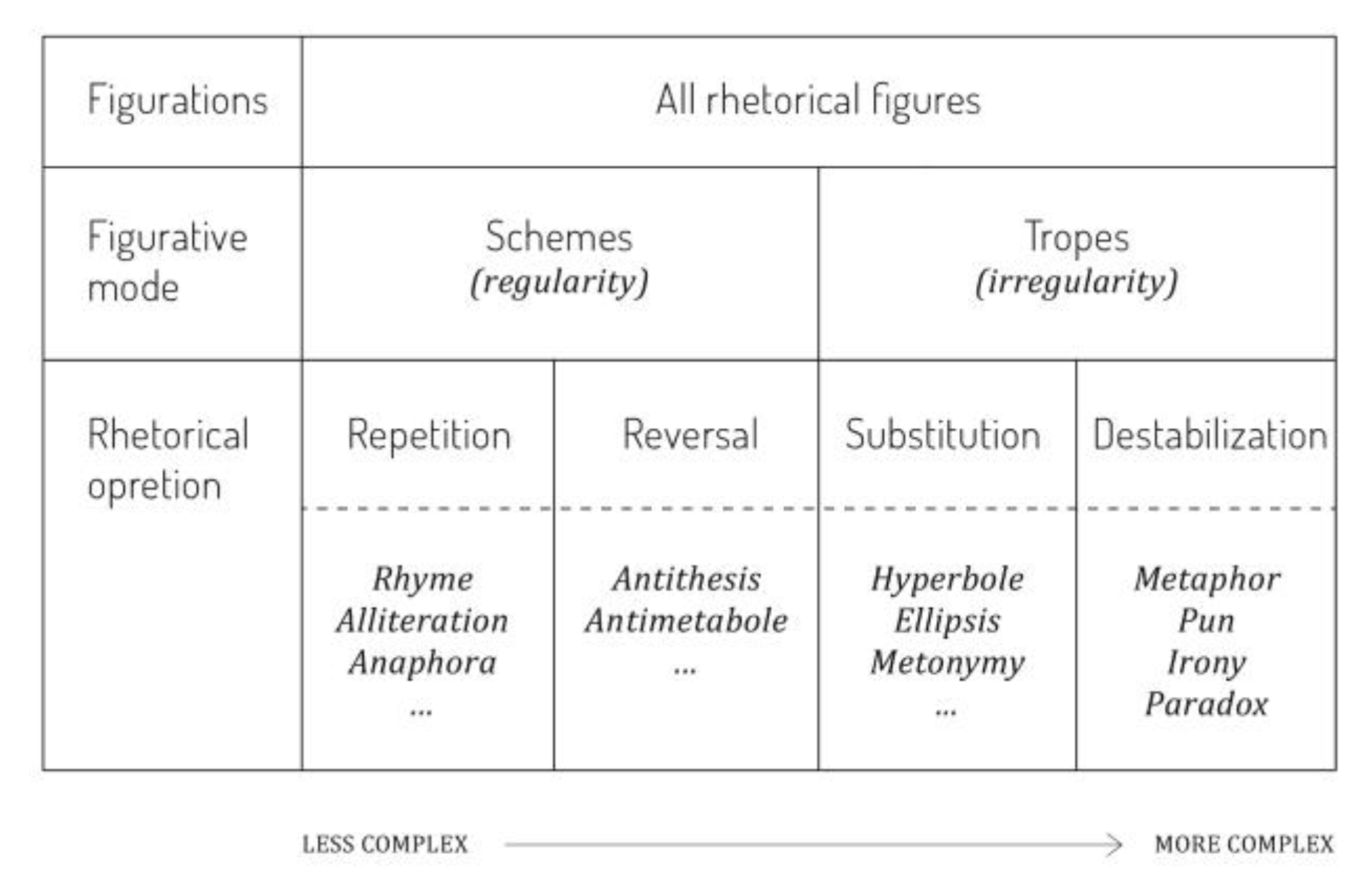
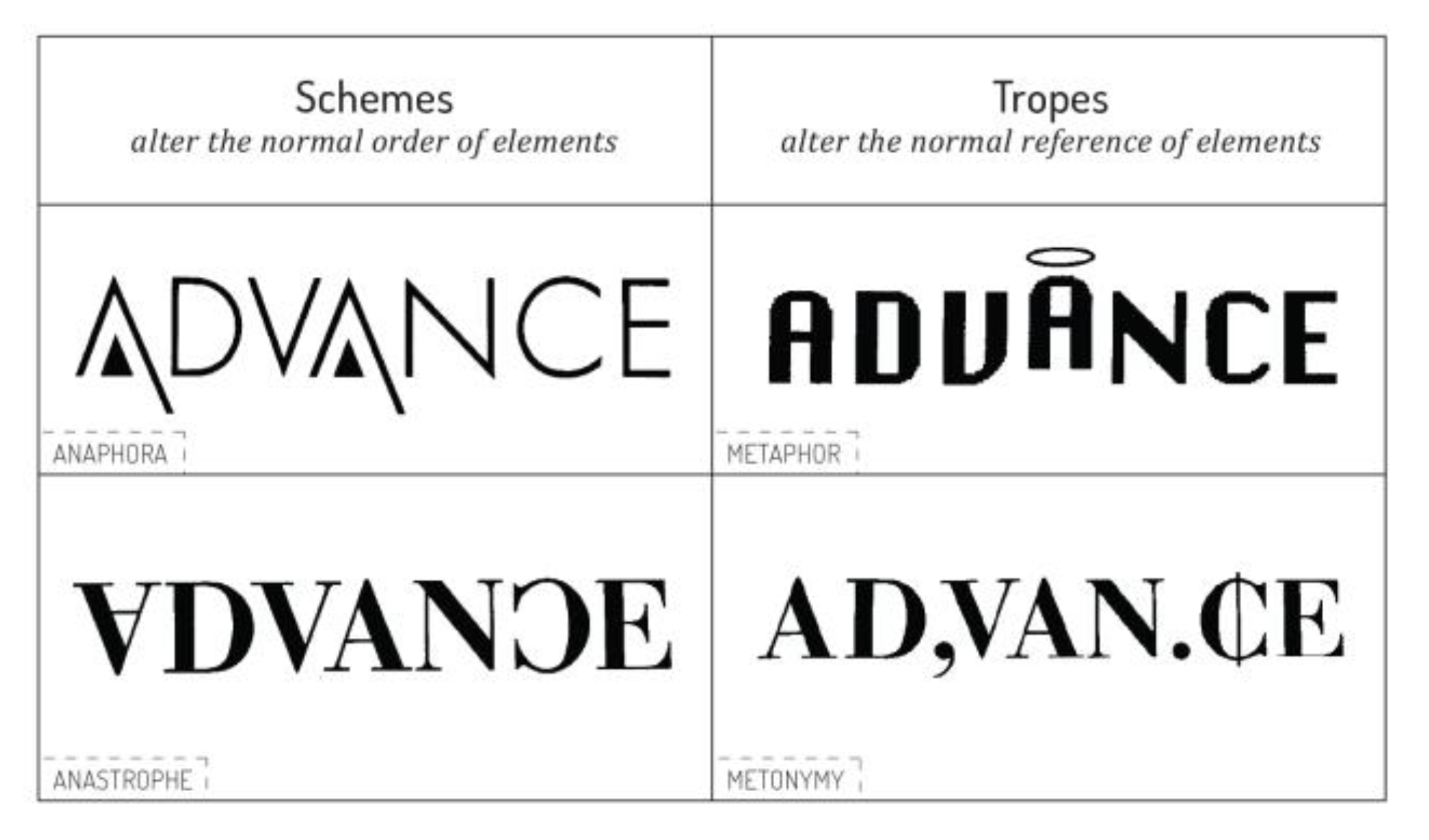


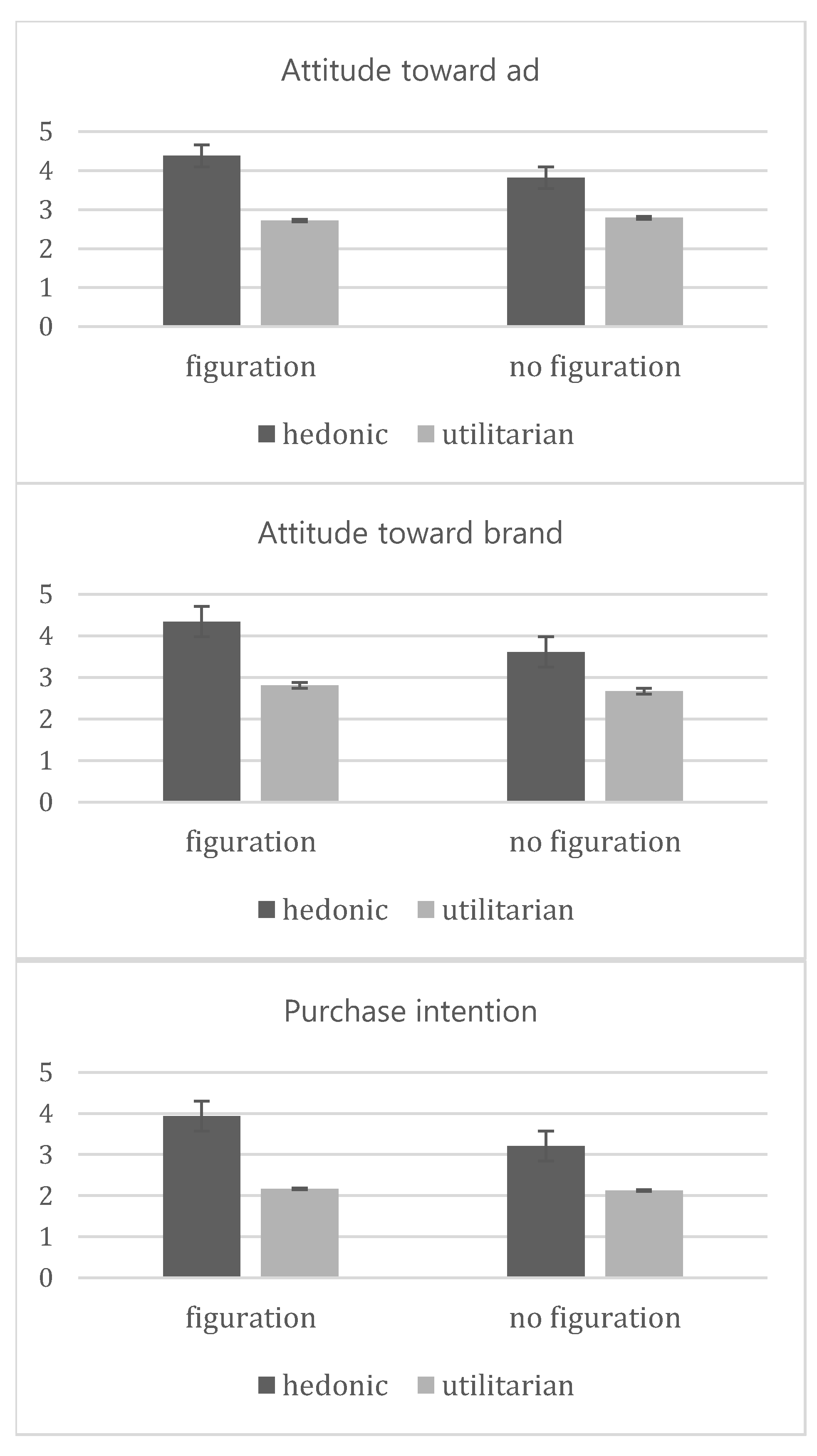
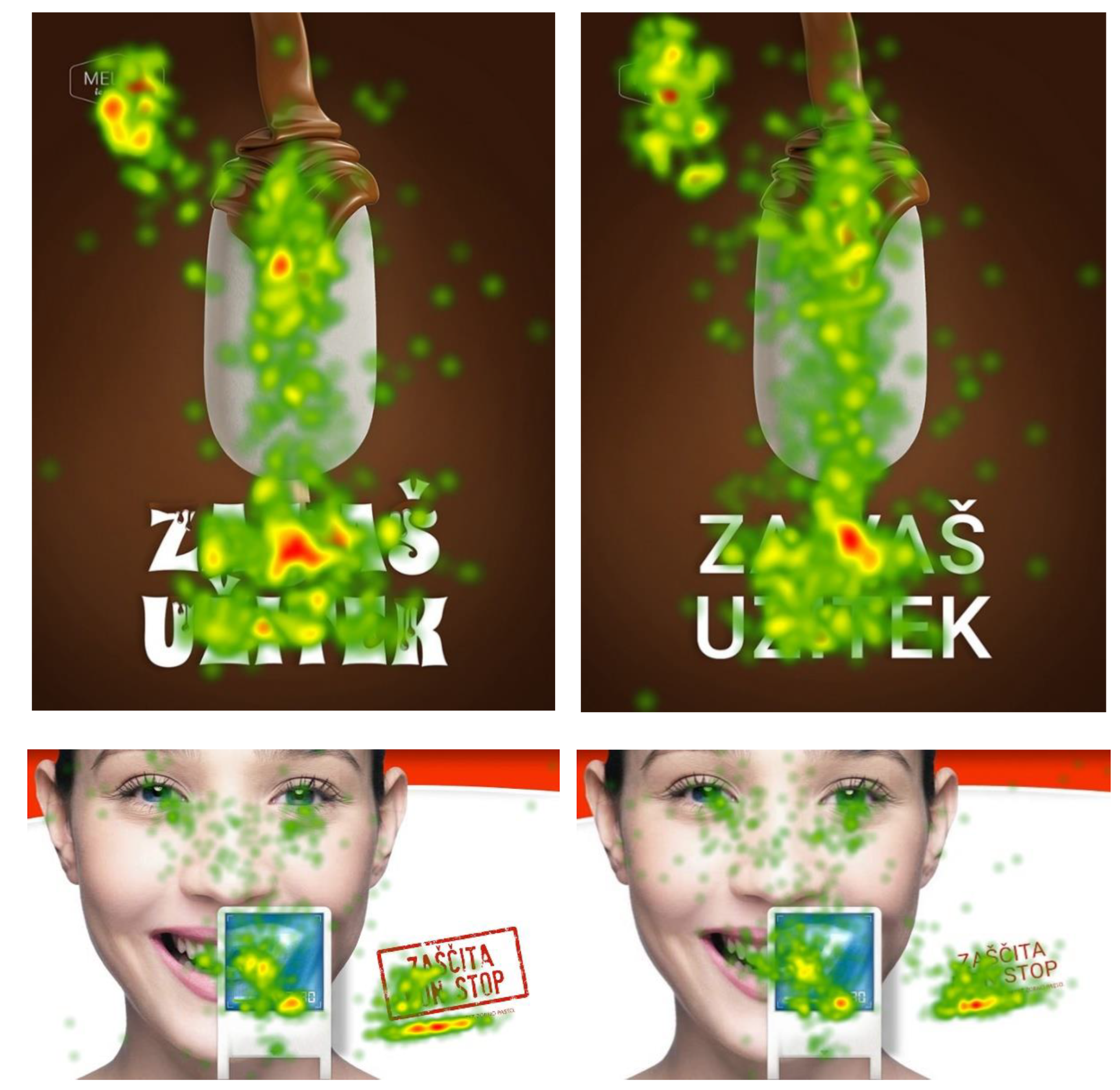

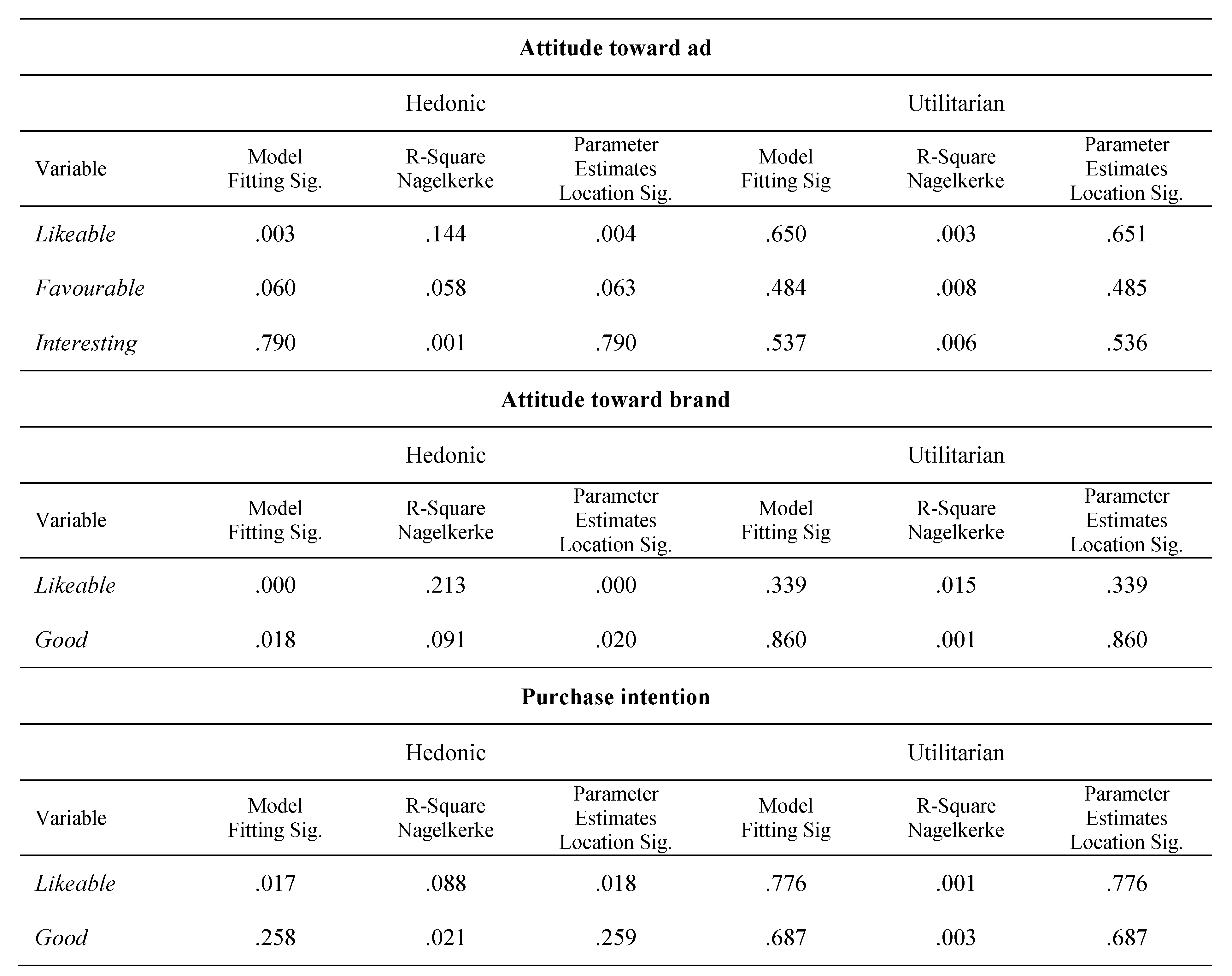


Copyright © 2016. This article is licensed under a Creative Commons Attribution 4.0 International License.
Share and Cite
Puškarević, I.; Nedeljković, U.; Dimovski, V.; Možina, K. An Eye Tracking Study of Attention to Print Advertisements: Effects of Typeface Figuration. J. Eye Mov. Res. 2016, 9, 1-18. https://doi.org/10.16910/jemr.9.5.6
Puškarević I, Nedeljković U, Dimovski V, Možina K. An Eye Tracking Study of Attention to Print Advertisements: Effects of Typeface Figuration. Journal of Eye Movement Research. 2016; 9(5):1-18. https://doi.org/10.16910/jemr.9.5.6
Chicago/Turabian StylePuškarević, Irma, Uroš Nedeljković, Vladimir Dimovski, and Klementina Možina. 2016. "An Eye Tracking Study of Attention to Print Advertisements: Effects of Typeface Figuration" Journal of Eye Movement Research 9, no. 5: 1-18. https://doi.org/10.16910/jemr.9.5.6
APA StylePuškarević, I., Nedeljković, U., Dimovski, V., & Možina, K. (2016). An Eye Tracking Study of Attention to Print Advertisements: Effects of Typeface Figuration. Journal of Eye Movement Research, 9(5), 1-18. https://doi.org/10.16910/jemr.9.5.6



